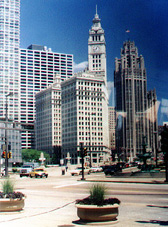 Social
ecology first emerged in Chicago with the recognition of ecologists and social
reformers that people's basic needs involve systematically related municipal
and natural services.
Social
ecology first emerged in Chicago with the recognition of ecologists and social
reformers that people's basic needs involve systematically related municipal
and natural services. Designing a well integrated community requires interweaving social with ecological conditions.
Social Ecology | Critical Thinking | Ecological Constraints | Leading Advocates | Terms | Goals
 Social
ecology first emerged in Chicago with the recognition of ecologists and social
reformers that people's basic needs involve systematically related municipal
and natural services.
Social
ecology first emerged in Chicago with the recognition of ecologists and social
reformers that people's basic needs involve systematically related municipal
and natural services.
Based on urban ecological studies on the boundaries of sociology, public health and ecological science, experts recognized the habitual needs of humans for food, clothing, shelter, health care and employment as analogous to, if not synonymous with, the needs of biological, physical and chemical surroundings in which the metropolis dwells. Reformers, motivated by European studies advocated urban renewal, parks and recreation, adequate child nutrition and a series of social reforms today referred to as entitlements of civil polities.
By employing critical thinking to creating a community, the participants in a design workshop are asked to take three steps.
Initially the necessity of braiding together the human needs and demands with essential ecological services requires, familiarity with materials, sites,impacts and means of reducing to a minimum the weight of the human imprint on the surroundings.
The next step involves reconceiving how native topographical features and cultural landscapes may be folded together in ways that either negate accumulating natural wealth or enhance the capacities of ecological systems to nourish human habitation with decreasing long term degradation of an area to sustain incoming residents.
In the last and final step by practicing good models of design and embodying green materials into their visions of a community, participants will:
explore,
analyze,
set priorities,
explain,
decide,
evaluate,
The proposals of one another to reach a consensus.
Concord Meeting House, Concord Massachusetts. [ 2003, J.V. Siry]
The town hall where the business of the people is conducted for the benefit of the community.
The essential demotic quality of the process by which all are
called upon to wish,
explore and finally judge the quality of an ecologically resilient community
to meet human demands means that concern and minimization of waste dwell at
the core of redesigned communities. The social and ecological elements, that
McHarg, Van der Ryn, and Lee argue are at the very core of a nourishing, healthy
and affordable place to live and work must achieve common goals
that preserve at once beautiful and ecologically functional landscapes; while
they are efficient in the delivery of services and economically adaptive to
meeting the needs of its members.
Any place is like a cube with interstitial elements inherent in its dimensions.
 Like
any three dimensional creation, designing the appropriate community means to
bring three measures together. Just as a box, a cube or a room has length and
width, so too does a place possess area. And as any square of a cube has depth
or height, so too do places possess an altitude in the contours of its relief.
So also must the measure of land, in order to gage the quality of its landscape,
coincide with the measure of population and the configuration of that population's
density. For both must complement, to the greatest extent possible the ecological
constraints that afford and inhibit certain means of attaining desired common
goals, expenditures and savings.
Like
any three dimensional creation, designing the appropriate community means to
bring three measures together. Just as a box, a cube or a room has length and
width, so too does a place possess area. And as any square of a cube has depth
or height, so too do places possess an altitude in the contours of its relief.
So also must the measure of land, in order to gage the quality of its landscape,
coincide with the measure of population and the configuration of that population's
density. For both must complement, to the greatest extent possible the ecological
constraints that afford and inhibit certain means of attaining desired common
goals, expenditures and savings.
By the measure of land we mean literally the space allotted for people to use as residential, commercial, transportation industrial, municipal and recreational sites.
By population we mean the full social array of conditions from security to safety that allow families and individuals to thrive at some wide range of optimal conditions; although commencing with density, the measure includes, health, pathology, services and common property resources to protect and nourish the community.
By the ecological measure employed in McHarg's ecological planning method, the full array of material conditions conjoin from the inanimate and the animate aspects of any place to provide a set of services, that communities dare not do without while creating a set of opportunities to preserve for the enjoyment of future generations.
This legacy aspect of the social and ecological measures adds depth and gives perspective to the measure of land as a place for dwelling, working or finding common ground.
Authorities
Green building, like ecological designs and the green roof movement grew out of a recognition by Frederick Law Olmsted, Sr. and Jr., Benton McKay, Paul and Percival Goodman, Lewis Mumford, Ian McHarg, and many others that the use of materials used to carry out the designs of even organic architecture such as Frank Lloyd Wright's had to be fundamentally reconciled, addressed from a minimalist perspective and built with a recognition that every structure has what Amory Lovins and others have called "embodied" energy. Driven into a conundrum, if not a bind of dumb design based on abundant materials that were once readily available in the 19th and early 20th centuries, ecological design has looked back to pre-industrial models of architecture that fits the materials, the energy and the wastes of any facility into a wider horizon of using fewer resources to have less of an impact on landscape, sources of ecological services and energy.
Social Learning is the outcome of a process in two parts: bounded conflict and adaptive management. By formulating field tests of our assumptions on a small scale, larger scale problems can be foreseen more effectively.
The ecological planning method requires a layered understanding of natural constraints as these feed human rational and emotional needs for community and a sense of accomplishment.
Four principles of ecological design are meant to inform the fifth essential principle that everyone does by intentional or unintentional actions redesign energy, material and artificial relationships.
The great central valley of California: John Wesley Powell's dream of a garden in the desert realized, in the grid pattern of the Jeffersonian land survey system (1785) straddling the winding path of the California Aqueduct
Related ideas:
Commons: what everyone needs to survive, prosper and be healthy.
Biocenose: the natural playing field on which human communities intrude, enhance or live together in proximity if not in mutuality.
Actions to take: means to arrest the creeping damage to social and ecological systems when actors ignore social and natural constraints.
Public Trust Doctrine is the developed body of precedent in the common law and cases pursuant to legal tradition that the flowing water belongs to the people, held in trust by an agency of the state to protect the constitutional rights to access these waters for purposes of hunting and fishing. In the modern world such a doctrine protects the quality of the water habitat required for fish, birds and especially non-game wildlife to thrive, without undue harm to the surrounding which sustain living systems.
TMDL, Total Maximum Daily Loads mandated by the Clean Water Act to determine the assimilative capacity of water bodies or stretches of flowing water to absorb polluting runoff, discharges and siltation.
For example,The EIP report applauds these continued efforts to reduce nitrogen pollution of the Chesapeake Bay to meet the 2010 Chesapeake Bay Total Maximum Daily Loads (TMDLs) – a cleanup plan for the Bay.
A recent study of the Chesapeake Bay revealed mixed results regarding nutrients.
Tempering the new findings, however, are ongoing concerns that Bay states will require stronger permitting, monitoring, and enforcement to meet their shared goal of a 25 percent reduction in nitrogen and phosphorus pollution in the Chesapeake Bay watershed by 2025. The states and EPA calculated that these reductions are the minimum necessary to restore the Bay’s water quality and support healthy aquatic life and fisheries.
Suburban sprawl in Maryland is killing organisms in Chesapeake Bay.
We must redesign the very core of a place to live, work, and nourish our needs.
These new designs must at once be naturally attractive and protective of ecological services provided by different landscapes because scenery is ecologically functional as well as beautiful. New designs must be efficient in the delivery of services and economically adaptive to meeting the changing conditions of a community's constituent members.
This road disappears as it moves north under a canopy of trees, as if disappearing into a New England forest, The highway is at once a bridge and a barrier to the outside world a link to the future and a repository of the past. That is because its material breadth suggests the scale of the 19th century wagon roads, its linearity the influence of survey implements from the late eighteenth century and the vehicle speeds along into the 21st century in search of a destination.
Bennington Vermont looking north into Massachusetts at Mount Greylock.
Social Ecology | Critical Thinking | Ecological Constraints | Leading Advocates | Terms | Goals


